The post Social media: Who will do the work in your org? appeared first on Socialbrite.
]]>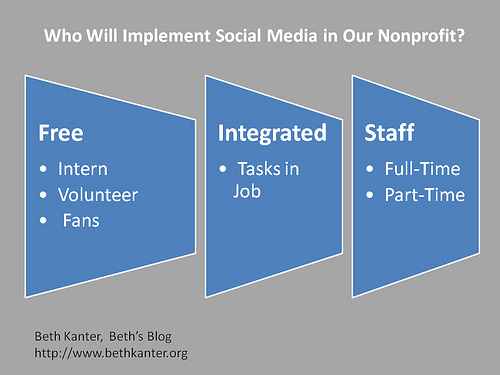
 No matter where I’m speaking or teaching workshops, the same questions come up:
No matter where I’m speaking or teaching workshops, the same questions come up:
• How much time does it take to do social media effectively?
• Who in our organization is going to do the work?
• How are ever going to find the time to do social media?
Social media does take time even if you are efficient. While the specific hour count can vary depending on what depth of your social media strategy, you need at the minimum couple of hours of week for a selective strategy. There are three options:
- Free: Leverage volunteers, fans, or interns
- Integrated: Review and prioritized tasks in existing job descriptions and make room for social media tasks
- Staffed: This can be quarter, half, or full-time
Of course, these options are not mutually exclusive. Here’s a great example of mixing the first two.
This year as part of my role as Visiting Scholar for Nonprofits and Social Media at the David and Lucile Packard Foundation, I’ve been coaching grantees. I’ve had the pleasure of working with ZER01, the producer of the 01SJ Biennial, a multi-disciplinary, multi-venue event of visual and performing arts, the moving image, public art and interactive digital media. The organization has a small administrative staff. The staff person responsible for social media is Danielle Siembieda, who has other responsibilities beyond social media.
Under the theme “Build Your Own World,” ZER01, in collaboration with dozens of partners, will present over the course of four days, from Sept. 16-19, hundreds of artworks, performances, events, and artist talks, which not only imagine the future of the world) but begin to build it.
Danielle’s challenge was how to creatively incorporate the use of social media to enhance the experience of the audience to select and participate in many different simultaneous arts events taking place. Given the Silicon Valley location, the audience would doubt have smart phones in hand and be likely to be posting on Facebook, Twitter, or checking into locations using Foursquare or the festival blog.
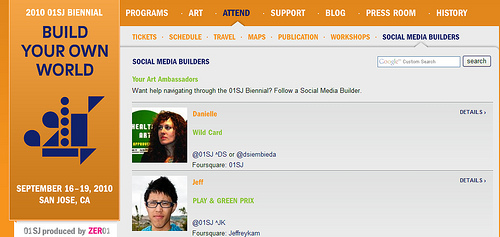
Danielle set up a Social Media Builders group of interns who are knowledgeable about the art work and comfortable using social media. During the three-day festival, they will be live tweeting events, engaging with the audience on Twitter, leaving tips on Foursquare, video blogging, photographing, and otherwise using social media to capture the event.
Each ”Social Media Builder” has a profile on the site. Each profile has their social media presence information and what they will be covering. The program book and other print materials will be distributed at the event to make people aware of the builders. They are encouraging audience members to ask them questions and engage with them during the performances and events. Danielle also did some training and prepared some cheat sheets for the volunteers to use.
This is a small pilot to understand the work flow, time commitment and to identify the most effective to incorporate social media into the event that enhances audience enjoyment and understanding of the art.
If you are in the Silicon Valley in the next few days, check out the event.
Article originally appeared at bethkanter.org.
 This work is licensed under a Creative Commons Attribution 3.0 Unported.
This work is licensed under a Creative Commons Attribution 3.0 Unported.
The post Social media: Who will do the work in your org? appeared first on Socialbrite.
]]>The post WeAreVisible: A new social media literacy site appeared first on Socialbrite.
]]>  Ifirst met Mark Horvath on Twitter and later face-to-face last December during a trip down the California coast during the holidays. Mark is a free agent championing the cause of homelessness.
Ifirst met Mark Horvath on Twitter and later face-to-face last December during a trip down the California coast during the holidays. Mark is a free agent championing the cause of homelessness.
A free agent is a person — many times a GenY, but not always — who is a passionate about a social cause but is working outside of a nonprofit organization to organize, mobilize, raise money and engage with others. Free agents are also fluent in social media and take advantage of the social media toolset to do everything organizations have always done, but outside of institutional walls. Sometimes they go on to form their own nonprofits like Amanda Rose and Manny Hernandez.
Last March at South by Southwest I helped Mark, along with colleague Geoff Livingston, compete for the top prize in the Pespi Refresh. He won the competition and the prize money was use to build the WeAreVisble site. Mark founded InvisiblePeople.tv, a nationally recognized nonprofit that fights homelessness using the power of social media. His new project is a social media literacy website to help homeless people learn how to use the Internet to tell their stories, build community and connect with support services.
The content is fantastic — particularly the tutorials. Help him spread the word to homeless service agencies, libraries, and other social service agencies. Nonprofits need to find and connect with free agents because they are powerful social change players. If you work with a homeless services agency, library or other social service agency that provides services to this group, you need to connect to this work!
Check out the animation video above, nicely done.
This article originally appeared at bethkanter.org.
 This work is licensed under a Creative Commons Attribution 3.0 Unported.
This work is licensed under a Creative Commons Attribution 3.0 Unported.
The post WeAreVisible: A new social media literacy site appeared first on Socialbrite.
]]>The post Does your nonprofit have a Dilbert social media policy? appeared first on Socialbrite.
]]>
 As part of my work as Visiting Scholar for Social Media and Nonprofits at the David and Lucile Packard Foundation, I’ve had the pleasure to do a number of workshops in the area. Monday evening I had the pleasure of presenting a Networked Nonprofit mini-workshop for a group of about 50 local nonprofits and government agencies in Palo Alto hosted by the Palo Alto Community Fund.
As part of my work as Visiting Scholar for Social Media and Nonprofits at the David and Lucile Packard Foundation, I’ve had the pleasure to do a number of workshops in the area. Monday evening I had the pleasure of presenting a Networked Nonprofit mini-workshop for a group of about 50 local nonprofits and government agencies in Palo Alto hosted by the Palo Alto Community Fund.
The participants represented a wide range of nonprofits from all-volunteer groups to larger institutions. The individuals included both staff and volunteers as well as different generations. I keep hearing from the “older generation” how aware they were of the importance of social media, but how difficult it was to change mindsets. After the session, I hear many say how they planned to go back and begin the transformation toward being a networked nonprofit!

Enoch Choi, a networked free agent for health care
One of the highlights is that I finally got to meet Enoch Choi, a doctor at the Palo Alto Medical Foundation who uses social media. I first “met” Enoch online through Netsquared in 2006 when I was putting together a presentation on nonprofits and the use of tagging. Enoch is a great example of a free agent, having organized trips to Haiti for physicians to volunteer during shorter periods.
In the workshop, I covered a few themes from my book The Networked Nonprofit, specifically social culture, transparency, and simplicity in part 1. Part 2 took a look at social media strategy principles. During part 1, there was an interesting discussion and insights shared by a participant from the City of Palo Alto as their process of developing its social media policy.
The process of developing a social media policy includes not only the written policy, but also the discussion. The discussion provides an opportunity for an organization to clarify it’s visual for social media. A social media policy should not be a “Thou Shall Not Document.” A policy is really two different documents. A short philosophical piece as well as a operations manual.
Here’s the presentation on Slideshare.net:
I don’t know if any of you are Dilbert fans, but this week the comic strip is taking a few swings at social media in organizations. Monday’s strip introduced “Beth,” who is the social media manager for an organization and her first day on the job. Go read it for a good laugh. Seriously, though, it is an important commentary on the tone of your social media policy.
What’s the tone of your social media policy? Is it encouraging or does it read like another Dilbert comic strip?
Cross-posted at bethkanter.org.
 This work is licensed under a Creative Commons Attribution 3.0 Unported.
This work is licensed under a Creative Commons Attribution 3.0 Unported.
The post Does your nonprofit have a Dilbert social media policy? appeared first on Socialbrite.
]]>The post Actionable analytics for your social media efforts appeared first on Socialbrite.
]]>
How to keep data collection from being an onerous task
 Lately I’ve been obsessed with the idea of SpreadSheet Aerobics, an actionable social media measurement strategy that is fit and trim and light on its feet. When I coach nonprofits on tactics and talk about measurement, their facial expressions change from happy to annoyed. Collecting data is often viewed as an onerous task. It doesn’t have to be that way.
Lately I’ve been obsessed with the idea of SpreadSheet Aerobics, an actionable social media measurement strategy that is fit and trim and light on its feet. When I coach nonprofits on tactics and talk about measurement, their facial expressions change from happy to annoyed. Collecting data is often viewed as an onerous task. It doesn’t have to be that way.
We know that it’s good practice to establish SMART objectives for your social media strategy and identify the audience before you execute. You need to think through your content and engagement strategy. You should also be thinking about what to measure and set up an efficient method for collecting that data. And, of course, making the time to think about what the data means.
We get so overloaded by meaningless data collection that we’re exhausted before we get to do the fun part: making sense out of it. I don’t try to measure everything. I find it overwhelming and a lot of it won’t help me refine my strategy. Spreadsheet aerobics is actionable data. What does that mean?
- Measurement should inform specific decisions and/or actions.
- Do not measure everything, but do measure what is most important to your objectives.
- The data you gather should help you learn.
Avoid drive-by analysis
 Another pitfall is doing “drive by” analysis. Let’s take Facebook Pages as an example. Rather than download a spreadsheet of the most important data points for a month from Facebook’s Insights analytics tools and comparing it against content, engagement and outreach strategies, administrators glance at the summary insights on their page and draw subjective conclusions.
Another pitfall is doing “drive by” analysis. Let’s take Facebook Pages as an example. Rather than download a spreadsheet of the most important data points for a month from Facebook’s Insights analytics tools and comparing it against content, engagement and outreach strategies, administrators glance at the summary insights on their page and draw subjective conclusions.
Avoid this measurement-as-therapy trap. When we see the green arrows pointing up and the numbers look good, we might think, “They like me, they really like me.” But you can’t really put that data into context and learn from it.
Here’s my spreadsheet daily and monthly routine. I grab the monthly daily data from the Insights tool (old version) and download into a spreadsheet. Out of the 25 or metrics I could look at, I only collect the following metrics:
- Total interactions
- Likes
- Comments
- New fans (Likes)
- Unsubscribes
- Page views
- Photo/video views (optional if I’m testing as content strategy)
I also have columns in a daily spreadsheet for labeled “content format,” “content topic” and “promotion.” In the content line, I put a link to the actual post, noting the type, voice or if it was a fan posting. I also make notes about what promotional tactics I used. Then, at the end of the month, I allocate a half hour to look at the numbers for the month in comparison to other months – and look for insights and trends.
In reviewing my spreadsheet, I discover what works. For example, open-ended questions work, particularly those that allow people to share their knowledge or ones accompanying a good resource link.
- Questions that encourage people to share wisdom about their social media strategy or tools: Anyone Using Flowtown to track social behavior of people on their email lists? Anyone Play With New Insights Tool?
- Questions that encourage people to share their take on a research report: Seniors Embrace Social Media Faster Than Other Segments, What Does That Mean for Your Nonprofit?
- Questions that encourage people to share resources: What are the Best Social Media ROI Posts?
- Questions that encourage sharing of stories, or What are the best approaches to managing bilingual Facebook Pages?
- Blog posts that summarize a discussion thread from the Facebook Page. For example, What Tools Does Your Nonprofit Use To Make Your Social Media Efficient?
I’ve looked at frequency of posting and day/time of the week but have learned what my sweet spot is for my audience on Facebook and no longer track it on a regular basis.
Final learnings
It is also important to track exactly how you promote your Facebook Page and what helps you recruit more fans. I keep notes on when I’ve tweeted a link, speaking dates, posting updates in my status about my Page and all the multi-channel ways you need to promote your page.
I’ve also discovered that it is important to identify as many opportunities to set up experiments that you measure and learn as you go. This is where I’ve gleaned most of my insights – a combination of quantitative metrics culled from Insights and what people are saying on the page.
What are you learning from your social media measurement strategy? How have you kept your data collection trim, fit, and actionable? What is the most compelling thing you learned about your social media strategy through measurement that lead to better results?
Image at top on Flickr by Anne Helmond
The original version of this was published at BethKanter.org.
 This work is licensed under a Creative Commons Attribution 3.0 Unported.
This work is licensed under a Creative Commons Attribution 3.0 Unported.
The post Actionable analytics for your social media efforts appeared first on Socialbrite.
]]>The post Ebook on how nonprofits can raise more money appeared first on Socialbrite.
]]>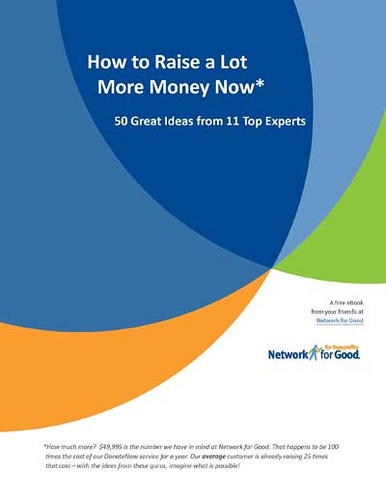
Guest post by Beth Kanter
bethkanter.org
It’s the sweltering dog days of summer and many nonprofits are deep into planning for year-end campaigns and perhaps looking for ways to raise money now. While I was sitting on the beach on vacation, Network for Good published a free ebook called How to Raise a Lot More Money Now – 50 Great Ideas from 11 Top Experts.
You’ll find lots of advice and tips from these experts. The authors include Jeff Brooks, Sarah Durham, Jocelyn Harmon, Kivi Leroux Miller, Mark Rovner, Nancy Schwartz, Chris Forbes, Alia McKee Scottand Katya Andresen. Allison Fine and I have contributed some tips from a chapter in The Networked Nonprofit on fundraising.
More than 7,000 people have downloaded the book (you have to fill out a form first) and the reviews have been glowing.
Favorite tips from the ebook
A few of my favorite tips:
- Ignore your brand guidelines. They are all about you, not about your donors, and that will hurt your fundraising.
- Organize a volunteer online thank-you corps. Donors get a simple training and are then assigned new donors to personally thank on behalf of the cause.
- Take a very long walk. You’re more likely to solve lingering problems with creative solutions if you give your brain a break. Really. Try it.
- If you’re having a creative block on the fundraising front, ask your child (or a family friend’s child) what your organization does. You will get a refreshing perspective that may inspire your next ask. There’s no better way to get out of the metaphorical weeds than to ask advice of someone who is only a few feet high.
Get your copy of How to Raise a Lot More Money Now – 50 Great Ideas from 11 Top Experts.
Republished from bethkanter.org.
Related
• Free nonprofit reports, whitepapers & ebooks (Socialbrite)
The post Ebook on how nonprofits can raise more money appeared first on Socialbrite.
]]>The post Craigslist Foundation Bootcamp coming up Aug. 14 appeared first on Socialbrite.
]]>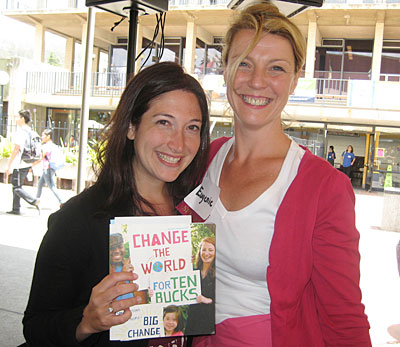
Randi Zuckerberg and Eugenie Harvey at last summer’s Craigslist Foundation Bootcamp.
Guest post by Beth Kanter
Zoetica
It has been a year since I’ve relocated to the Bay Area in California. The summers here are much less humid than on the East Coast, but the real treat is having the Craigslist Foundation Bootcamp practically in my backyard. The next btootcamp takes place on August 14 – I wouldn’t miss it.
Last year, I was honored to be a workshop leader at Craigslist Foundation Nonprofit Bootcamp, but was even better is that the sessions on the program were really good and I learned a lot. I’ll be doing a session this year on The Networked Nonprofit, but really looking forward to hearing the keynotes as well as the sessions.
This year’s bootcamp is focused on strategies for fostering and building communities with sessions led by incredible people in the field. The one-day schedule is a chance to participate in interactive workshops, meet people who can turn dreams into action, receive expert coaching, and get fired up by stories of successful community transformations. There are also opportunities for private coaching sessions, break-out sessions, and camaraderie with other passionate change-makers – not to mention pre- and post-event meetups.
Lots more information here: Boot Camp website and you can purchase a ticket here.
This post originally appeared at bethkanter.org.
 This work is licensed under a Creative Commons Attribution 3.0 Unported.
This work is licensed under a Creative Commons Attribution 3.0 Unported.
The post Craigslist Foundation Bootcamp coming up Aug. 14 appeared first on Socialbrite.
]]>The post Use tweetups to bridge offline & online appeared first on Socialbrite.
]]>
Guest post by Beth Kanter
bethkanter.org
Networked nonprofits know how to close the loop between social media and offline actions. They understand that it is a scaffolded process. Whatever channel they use, they’re building a bridge from online to on land. They’re masters at meeting their audience where they’re at and bringing them further along the ladder of engagement.
Take Twitter, for example. Once a nonprofit has developed a presence and a network – and has integrated regular and engaging tweeting into the workflow, the next step is to host a tweetup. What’s a tweetup? It’s an in-person meeting of Twitter users.
There are different types of tweetups. Some are spontaneous and informal. Others are pre-scheduled events with activities and presentations or part of an existing event. There is no single right way to do them.
The benefits of hosting a tweetup include deeper relationships, lead generation and more exposure. It can also lead to memberships, and it can be a good way to meet your Twitter followers or identify who in your existing audience is using Twitter.
Tweetups are perfectly suited for performing arts organizations that may have pre-concert tweetups or a museum that is offering a “young professionals event.” A quick search of museum tweetups show many results including the recent Hubble and Holst, with a private showing of the Hubble 3D IMAX at the Houston Museum of Natural Sciences and a special performance by Houston Symphony musicians.
Tips on holding live events
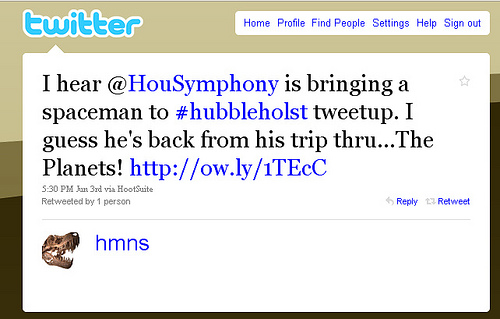
Before the event
Tweet before the tweetup to build excitement.
Use a unique hashtag: A hashtag is a keyword that opens up and connects public conversations on Twitter. You’ll want to designate one for your event and use it before, during and after the event.
Scope out the location: Make sure it is networking friendly, so people can chat and exchange business cards. Also make sure there is decent wifi (or cell phone reception).
Use social media event software: Three of those resources are Meetup.com, Eventbrite and TwTvite. They all have free elements to their service. If your organization has a robust Facebook presence, you can also use a Facebook Event to promote the event.
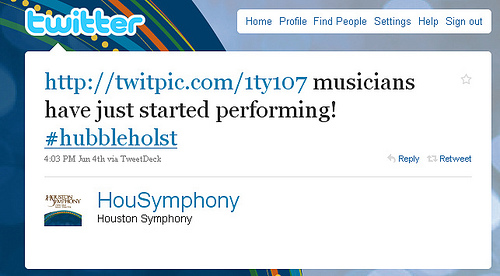
During the event
Encourage live tweeting during the event and don’t forget to encourage photos.
Name gags: Make sure you have name tags. If are you hosting, be a good host and introduce people.
Activities: If the event will be more than a networking event, have some structure activities or presentations. Be creative. Have fun. Also encourage people to live tweet from the event. If you have a projector and laptop available, you may want tostream the Twitter feed during the event.
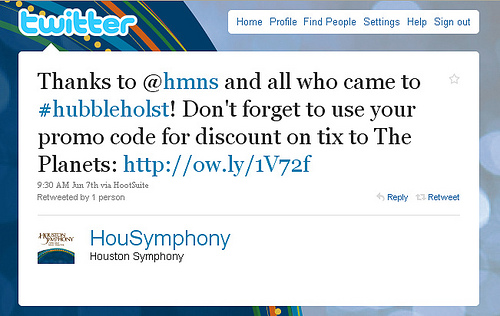
After the event
Keep in touch. Encourage attendees to participate in other programs.
Connect: Continue to engage with Twitter followers after the event and encourage them to participate in other organizational activities. Don’t forget to have an email list sign up at the event.
Resources
How To Host Successful Tweetups (Mashable)
How Tweet Ups Can Benefit Your Marketing Strategy (Social Media Examiner)
What’s A Tweet Up? (TwiTip)
Planning TweetUps (TwiTip)
Nina Simon interviews Shelley Bernstein about Brooklyn Museum 1st Fans (MuseumTwo)
What are your best tips for hosting tweetups? Have a success story? Share it in the comments.
This article originally appeared at bethkanter.org.
 This work is licensed under a Creative Commons Attribution 3.0 Unported.
This work is licensed under a Creative Commons Attribution 3.0 Unported.
The post Use tweetups to bridge offline & online appeared first on Socialbrite.
]]>The post Twitter tip: Choose whom you follow strategically appeared first on Socialbrite.
]]> For the past few years whenever I doing a training or talk about nonprofits and social media and more recently when we’ve presented about the book, The Networked Nonprofit, someone always raises this concern: “Social media is a time suck.”
For the past few years whenever I doing a training or talk about nonprofits and social media and more recently when we’ve presented about the book, The Networked Nonprofit, someone always raises this concern: “Social media is a time suck.”
Networked nonprofits are not only experts in using social media, but they know how to streamline their workflow often based on an understanding of applying network theory to their practice.
It isn’t about following thousands and thousands of friends on Twitter. We don’t have the time or brain cells for that. It’s about finding people who are connected to different social circles and following them. Of course you have to be interested in what information or conversations they are sharing on Twitter. Identifying these people — what writer Vladis Krebs calls “nodes” — is at the core of social network analysis.
What if you have been following people without thinking and now have an overloaded Twitter stream? Here are some tips to help you tame the Twitter lion.
What is most important to find and cultivate the connectors and weavers in communities or topics of interest. There are some free tools that can help you visualize your Twitter network or do quasi social network analysis on Twitter.
Twitter tools to measure your influence
Here are a few tools that I’ve used:
• Use Friend or Follow to download a spreadsheet of followers. Sort the information to find people you should get to know. This works best if you have small network.
• Mr. Tweet finds people in your network you should follow — use this after you have built up your following list.
• Twitalyzer is a terrific analytics tool that gives you some good benchmarking metrics for Twitter. Run the impact report to help you identify influencers.
• Mailana can help you identify people who have a strong affinity with your cause or organization. I wrote about an experiment I did last year using this tool. One limitation is that it doesn’t analyze your network in real time. You submit the user ID and then have to come back a few days later unless it is already in the database.
• Twiangulate lets you analyze cross over between your Twitter network and another Twitter user. This can be useful to find potential collaborators.
• Klout lets you track the “influence” of specific Twitter users, including the growth of their network, who they influence, and who they are influenced by.
• Mention Map helps you visualize who is interacting with you around which hashtags. It shows nodes on your network. There is not information about how its drawings are created, though.
Tips for Twitter Lists
Once you’ve started to identify connectors and people to follow, you’ll need to manage it. Twitter Lists can help you create subgroups of all your followers.
• Create Twitter Lists of those accounts, organized by topic or community.
• Keep the lists small and manageable.
• Add these lists to your Twitter client and set up a schedule to monitor. This makes the Twitter content feel more grounded, as opposed to just flying by.
• Create Twitter searches for keywords to find additional sources. Follow them as needed.
• Tend to your lists regularly and unfollow people who don’t provide value to you, perhaps people who tweet about things you are not interested in.
Apply a little social networking theory and think before you follow. Ask yourself, if you were stuck on desert island and could only follow 150 people, who would you choose? How many people do you follow and why? How do you manage it?
Cross-posted from Beth’s blog.
 This work is licensed under a Creative Commons Attribution 3.0 Unported.
This work is licensed under a Creative Commons Attribution 3.0 Unported.
The post Twitter tip: Choose whom you follow strategically appeared first on Socialbrite.
]]>The post 9 ways nonprofits should be using Slideshare appeared first on Socialbrite.
]]> For a couple of years, I’ve been an avid member of the Slideshare community, sharing, browsing and collaborating on content and watching how nonprofits use the platform. As I was reflecting about Slideshare and thinking about the characteristics of nonprofits featured in our book, The Networked Nonprofit, I realized that Slideshare is a haven for them.
For a couple of years, I’ve been an avid member of the Slideshare community, sharing, browsing and collaborating on content and watching how nonprofits use the platform. As I was reflecting about Slideshare and thinking about the characteristics of nonprofits featured in our book, The Networked Nonprofit, I realized that Slideshare is a haven for them.
Networked nonprofits are simple, transparent organizations. They make it easy for outsiders to get in and insiders to get out. They engage people to shape and share their work to raise awareness of social issues, organize communities to provide services or advocate for legislation. In the long run, they are helping to make the world a safer, fairer, healthier place to live.
I drank the Slideshare Kool Aid in November 2006. Today I have almost 200 presentations in my account, some with tens and thousands of views. Presentations and instructional content are an important part of my content strategy and the lifeblood of my work as a trainer. Slideshare helps set my work free and share it with nonprofit professionals all over the world.
Although PowerPoint has a reputation for being a deadly weapon, networked nonprofits know that when they give their presentations (and other documents) a social life, it can brings their objectives to life. Let’s look at the different ways they use Slideshare (or should be).
Networked professional development & learning
1Three years ago, I wrote a post about how Slideshare supports networked learning and networked professional development. This is what Nancy White is calling “Triangulating Professional Learning.” It’s the ability to learn from professionals inside and outside of your field. As Slideshare has excellent social media content, I can view slide shows across different types of industries and networks. I don’t have be a networked silo!
Discover, interact & learn from thought leaders
2I love the fact that I can see slide presentations from some my favorite thinkers in the social media field, literally hours before or after they’ve given the presentation — for example, David Armano, Dave McClure and Guy Kawasaki. But you can also find thought leaders in the social sector publishing their decks to Slideshare — for example, Amy Sample Ward, Danielle Brigida and Michael Edson. And it isn’t just individuals. You can grab the most recent research from the Pew Research Center’s Internet & American Life Project.
Informal collaboration with peers
3One of the best experiences I ever had learning and collaborating with peers was setting up a sandbox for network weavers. We set up a group in Slideshare to share and remix our slide presentations.
Create an archive for conference presentations
4Perhaps the most common use of Slideshare by nonprofits is setting up groups or events to collect conference presentations in one place so participants can find them. I like the fact that I can find the presentations from sessions I attended as well as those from sessions I didn’t attend. NTEN set up an event area on Slideshare for the NTC 2010. Some events have set up branded channels, like the Bar Camp Channel.
Training
5Nonprofits that offer training as one of their programs have embraced Slideshare. These include CanadaHelps, Npower Michigan and Michigan Nonprofit Association. NTEN’s WeAreMediaproject has taken this a step further and uses Slideshare so trainers can remix each other’s decks.
Fundraising
6I have not come across too many organizations using Slideshare for fundraising, although I’ve seen a few breathtaking decks created by “free agent” fundraisers for disaster relief efforts over the years. These include Nargis Cyclone and China Earthquake
Advocacy
7These have come in the form of awareness events like Earth Hour and Yoga to End Poverty.
Sharing your organization’s story
8The National Wildlife Federation uses Slideshare for its presentations, but also to promote the winners of their photo contests. The Counterpart uses Slideshare to share its annual report information. Here’s a slideshow that summarizes research interviews of donorsfrom a local humane society. And, a missing child alert.
Tool to share draft documents and get feedback
9The Red Cross used Slideshare to share its social media policy and get feedback. See its presentation, Social Media Handbook for Red Cross Field Units.
How is your nonprofit using Slideshare?
Cross-posted from Beth’s Blog.
 This work is licensed under a Creative Commons Attribution 3.0 Unported.
This work is licensed under a Creative Commons Attribution 3.0 Unported.
The post 9 ways nonprofits should be using Slideshare appeared first on Socialbrite.
]]>The post 9 ways nonprofits can excel using social media appeared first on Socialbrite.
]]>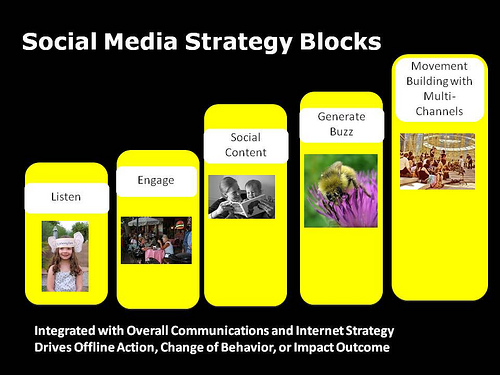
 Iwas honored to be the keynote speaker for the Bay Area Microsoft/TechSoup Global Connection Day last week. My presentation on Slideshare takes the audience through my Principles for Effective Social Media. The principles cover strategy, learning, capacity, and organizational culture, and each principle is illustrated with some practical and tactical advice that ladders up to strategy.
Iwas honored to be the keynote speaker for the Bay Area Microsoft/TechSoup Global Connection Day last week. My presentation on Slideshare takes the audience through my Principles for Effective Social Media. The principles cover strategy, learning, capacity, and organizational culture, and each principle is illustrated with some practical and tactical advice that ladders up to strategy.
My opening framework breaks down the strategy into strategy blocks. These incremental chunks that can be laddered up to program or communications goals. I urge people to think of the chunks and then the tools. You begin slowly with small steps and build up to your capacity level. This is the crawl, walk, run and fly approach used by NASA and later by Obama.
Here are 9 ways nonprofits can excel using social media:
-
1Social media must be integrated with internet communications or program strategy
Begin with a communications and program assessment that helps you best determine where social media brings value, the objective, audience, and budget. Use an excel spreadsheet to look at events, fundraisers, programs, web site content, performances, and other activities to socialize.
Examples: Wildlife Direct and Brooklyn Museum
2Use listening techniques to develop a deep understanding of the audience
Organizations must begin with listening, but an integrated listening channel that includes social media and traditional marketing channels. I cover a couple techniques and tools using participants as an example to illustrate that keywords are king. And, of course, many of the listening tools like Radian 6 or free ones like Social Mention allow you export your listening streams into Excel spreadsheets!
Example: Red Cross
3 Use conversation starters to engage your target audience
The most important thing for nonprofits is to shift from messaging to conversation starters based on listening. And of course, you can use a spreadsheet to plan out your conversation starters!
Examples: San Jose Opera use of #Operaplot Twitter Hashtag
4 Identify influencers in social media spaces and cultivate them
I introduce a couple of basic social network analysis concepts and how they apply to an organization’s friends, fans, and followers on social media sites. I also mention other tools like Friend or Follow or NodeXL both of which make influencer analysis more efficient with the ability to export the data into an excel spreadsheet.
Example: Northern California ACLU social network analysis of their followers on Twitter.
5 Make sure your content has a social life
This point is about making sure you are thinking about your web site content and social media outposts in an integrated content strategy. Also, the way people are consuming content is changing because of social media. We can no longer think of our web sites as the one stop destination to get the whole context. People are more likely to stumble upon content in small chunks via their friends on social networks. This changes how nonprofits need to think about web social content strategy and how to make it efficient.
Here’s where I had a lot of fun pulling up screen shots of participants Web and Social Media outposts.
6 Use social media to close the loop between online and offline action
This is about making sure that your social media is integrated into all marketing channels and that you have to think in both directions — from offline to online and online to offline. I give some very specific tips here.
7 Allocate enough staff time and have the expertise to implement the strategy
I start with a crawl-walk-run-walk framework for staffing models for nonprofits. I also talk about tracking the time because working on social media can give you ADOLAS (AD – oh look a squirrel!) If you track you time and have specific tasks, you know what you’re getting for your time investment. It’s just one step away from looking at ROI. I had a funny picture of a Squirrel and shouted out Squirrel at random points during the presentation.
8 Launch small pilots and reiterate using the right metrics to understand what is and what isn’t working
I talk about spreadsheet aerobics and other measurement tips. There are many ways to use Excel. Take, for example, my Facebook Analysis Excel template. (Join my fan page, read the thread, and the link is at the bottom.)
9 Assess organizational culture and have strategies to address issues that may prevent adoption
I’ve been writing about technology adoption and culture change for a long time and how it applies to social media. I also offer some pointers around developing a social media policy. This is a big theme in my book, The Networked Nonprofit – so stay tuned.
How is your nonprofit excelling at social media?
Cross-posted from Beth’s Blog.
 This work is licensed under a Creative Commons Attribution 3.0 Unported.
This work is licensed under a Creative Commons Attribution 3.0 Unported.
The post 9 ways nonprofits can excel using social media appeared first on Socialbrite.
]]>